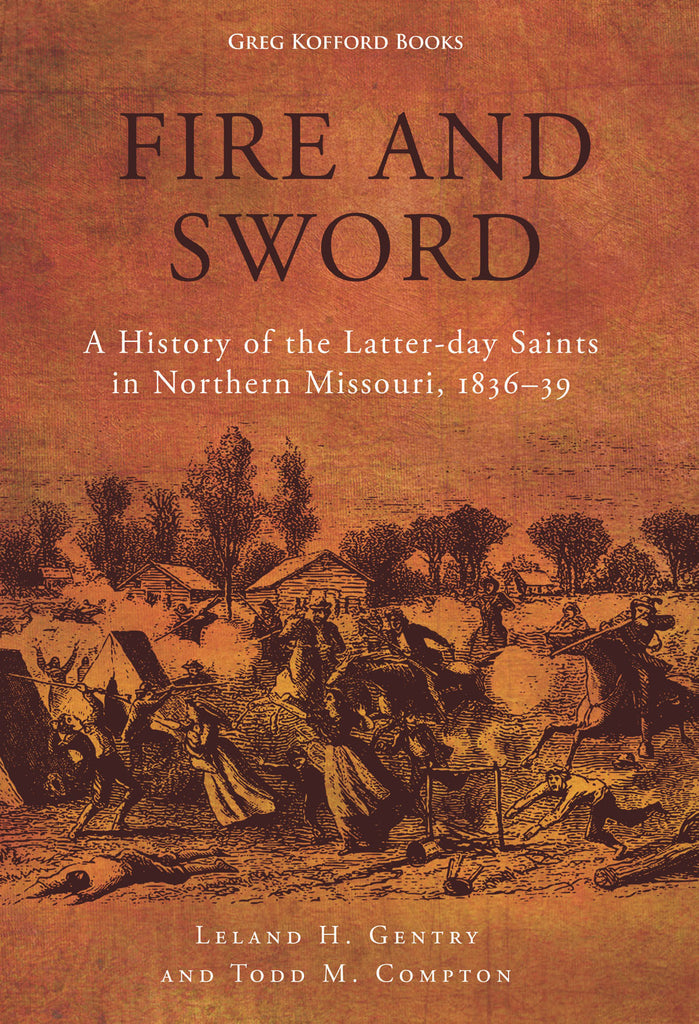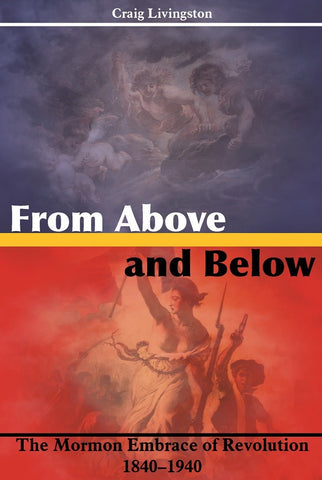Fire and Sword: A History of the Latter-day Saints in Northern Missouri, 1836-39
$36.95
By Leland Homer Gentry and Todd M. Compton
- “An invaluable contribution.” — Journal of Mormon History
- “Fire and Sword’s appearance could not have been more timely.” — The Juvenile Instructor



Available in ebook for Kindle, Nook, Apple, Google Play, and Kobo.
Book Description:
Many Mormon dreams flourished in Missouri. So did many Mormon nightmares.
The Missouri period--especially from the summer of 1838 when Joseph took over vigorous, personal direction of this new Zion until the spring of 1839 when he escaped after five months of imprisonment--represents a moment of intense crisis in Mormon history. Representing the greatest extremes of devotion and violence, commitment and intolerance, physical suffering and terror--mobbings, battles, massacres, and political “knockdowns”--it shadowed the Mormon psyche for a century.
Leland Gentry was the first to step beyond this disturbing period as a one-sided symbol of religious persecution and move toward understanding it with careful documentation and evenhanded analysis. In Fire and Sword, Todd Compton collaborates with Gentry to update this foundational work with four decades of new scholarship, more insightful critical theory, and the wealth of resources that have become electronically available in the last few years.
Compton gives full credit to Leland Gentry's extraordinary achievement, particularly in documenting the existence of Danites and in attempting to tell the Missourians’ side of the story; but he also goes far beyond it, gracefully drawing into the dialogue signal interpretations written since Gentry and introducing the raw urgency of personal writings, eyewitness journalists, and bemused politicians seesawing between human compassion and partisan harshness. In the lush Missouri landscape of the Mormon imagination where Adam and Eve had walked out of the garden and where Adam would return to preside over his posterity, the towering religious creativity of Joseph Smith and clash of religious stereotypes created a swift and traumatic frontier drama that changed the Church.
Comprehensive Table of Contents:
.
Preface
Introduction
Organization of This Study
Review of the Literature
Contributions of This Study
Acknowledgments
Addendum
Part 1: Settlement
1. Mormons on the American Frontier
Early Frontier America
Frontier Religion
The Westerner: Land and Character
Ideological Background
Jackson County
Attempts at Legal Redress
Solutions to the Problem Proposed and Rejected
Addendum
2. “Be It Enacted”: The Founding of Caldwell County
Clay County Requests the Mormons to “Move On”
Plans to Move North
Final Decision to Locate in Northern Ray County
The Saints Move into Northern Ray County
The Establishment of Caldwell County
Summary and Conclusion
Addendum
3. “Plenty to do”: The Early Growth of Far West and Vicinity
The Growth and Settlement of Far West
Building Developments at Far West
Educational Developments at Far West
Business Developments
Attempts at Local Government
Attempts to Solve Financial Difficulties
Efforts to Build a Temple at Far West
The Need for Other Settlements
Conclusion
Addendum
4. “Salt That Has Lost Its Savor”: The Origin, Rise, and Expulsion of the Dissenters
The Case of the Presidents in Zion
Failure of the Kirtland Safety Society Anti-Banking Company
The Dissenters at Far West
Action against the Presidents in Zion
The Case of Oliver Cowdery
The Case of David Whitmer
The Case of Lyman E. Johnson
Further Action against the Dissenters
Summary and Conclusions
Addendum
5. The Prophet in Zion: Spring and Summer, 1838
Smith’s and Rigdon’s Journey to Far West
First Presidency Financial Problems
The Church’s Financial Difficulties
Administrative Problems and Attempts to Solve Them
Revelations and Doctrinal Developments
Literary Activities
Political Activities
Sidney Rigdon’s Fourth of July Oration
Addendum
6. “A Beautiful Elevated Spot of Ground”: The Settlement of Adam-ondi-Ahman and Dewitt
Early Settlements in Daviess County
Description of Daviess County
Exploration and Settlement in Daviess County
Growth and Development of Adam-ondi-Ahman
The Significance of Adam-ondi-Ahman
The Stone Altar at Adam-ondi-Ahman
The Settlement at DeWitt
Conclusion
Addendum
Part 2: Conflict
7. “Knock Down” at Gallatin: Troubles in Daviess and Carroll Counties
Warnings before the Battle
The “Election-Day Battle”
The Visit to Judge Adam Black
Reaction in Ray County
Joseph Smith and Lyman Wight before Judge King
Stolen Government Arms and Their Recovery
Temporary Peace in Daviess County
The Court of Inquiry in Daviess County
Trouble Begins in Carroll County
Threatened Outbreak of Hostilities
Unheeded Appeals to Civil Authorities
The Saints Agree to Depart
Aftermath
Conclusion
Addendum
8. The “Big Fan”: The Role of the Danites
Organization of the Danite Band
Purposes of the Danite Band
The Mormon Concept of the Kingdom of God
Danites and the “Armies of Israel”
The Danite Constitution
Danite Teachings and Practices
The Danites and the First Presidency
Avard’s History, Character, and Methods
Addendum
9. “In the Name of Lazarus, God, and the Lamb, Fire!”: The Daviess County Raid, Battle of Crooked River, and Boggs’s Extermination Order
Preparations for War in Daviess County
The Mormons Seize the Initiative
Stealing and Burning
Preparations for War in Caldwell County
The Pace Quickens
The Battle of Crooked River
Governor Boggs’s Extermination Order
The Force against the Mormons
The Governor’s Actions Considered
Addendum
10. “Nits Make Lice”: Massacre at Haun’s Mill
The Haun’s Mill Settlement
Joseph Smith’s Counsel Disregarded
Attempts at Peace and Preparations for Defense
The Attack
The Flight of the Mormons
The Militia Concludes Its Work
The Non-Mormon Withdrawal
A Scene of Horror and Devastation
The Roll Call of the Dead
After the Massacre
Responsibility for the Massacre
Aftermath
Conclusion
Addendum
11. Surrender at Far West: The Mormon War Concluded
Preliminary Action against Far West
Events of Tuesday, October 30
Events of Wednesday, October 31
Events of Thursday, November 1
Events of Friday, November 2
The Arrival of General Clark and Its Aftermath
The Surrender of Adam-ondi-Ahman
The Legal Status of the Troops at Far West
General Atchison’s Departure from the Field
George M. Hinkle’s “Treason”
Alexander Doniphan’s Courageous Insubordination
Conclusion
Addendum
Part 3: Exodus
12. “Where Is Liberty?”: The Richmond Hearing, Imprisonment, and Escape
The Stop-over in Independence
Imprisonment at Richmond
General Clark and the Prisoners
The Hearing at Richmond
The Alleged Partiality of Judge Austin A. King
The Imprisonment at Liberty Jail
Attempts to Secure a Formal Trial
Attempts at Escape
The Grand Jury Trial in Daviess County
The Prisoners’ Escape from Missouri
The Prisoners at Richmond
Summary and Conclusions
Addendum
13. “Chased from Everything Dear on Earth”: The Exodus
Final Removal from Daviess County
Far West
Appeals to the Legislature
Efforts to Leave the State
The Question of Where to Settle
Non-Mormon Purchases of Mormon Lands
Suffering during the Exodus
The Twelve Apostles and the Far West Temple Site
Postscript on Far West
Addendum
14. Aftermath: Attempts at Investigation and Redress
The Question of an Official Investigation
Paying the Troops Involved in the Mormon War
Publishing the State’s War Documents
Criticism and Defense of Boggs and Missouri
LDS Attempts to Influence Public Opinion
Publications from the Non-Mormon Perspective
Seeking Redress from Congress
15. The Mormons in Northern Missouri: Evaluation and Retrospective
Addendum
Bibliography
Index
Praise for Fire and Sword:
“Gentry used more thoroughly than any scholar before him the official documents published by the State of Missouri and the U.S. Senate in the aftermath of the Mormons’ departure from the state, which contained the correspondence between Boggs and his militia commanders. . . . Utilizing these sources demonstrated Gentry’s willingness to move beyond ‘traditional’ Mormon interpretive frameworks and seek to understand alternative points of view. Fire and Sword’s appearance could not have been more timely.” — David G, The Juvenile Instructor.
“Historians of the Mormon experience have long recognized the invaluable contribution of Leland H. Gentry's path-breaking dissertation.” — Alexander Baugh, Journal of Mormon History
About the Authors:
Leland H. Gentry, author of the groundbreaking doctoral thesis on which this book is based, and numerous important articles on Mormons in Missouri, received his Ph.D. from Brigham Young University in 1965. He taught for many years in the LDS Church Educational System, in Tooele, Cedar City, Logan, and Salt Lake City, Utah, and opened the first seminary and institute east of the Mississippi, in Ithaca, New York. He married Myrna Miller in 1952; they had five children. He died on August 6, 2007, after a thirty-five-year battle with multiple sclerosis.
Todd M. Compton is the author of In Sacred Loneliness: The Plural Wives of Joseph Smith (Salt Lake City: Signature Books, 1997), which won best book awards from the Mormon History Association and the John Whitmer Historical Association; and Victim of the Muses: Poet as Scapegoat, Warrior, and Hero (Center for Hellenic Studies/Harvard University Press, 2006). With Charles Hatch, he edited A Widow’s Tale: The 1884-1896 Diary of Helen Mar Whitney (Logan: Utah State University Press, 2003), which won the Best Documentary Book award from the Mormon History Association. He works as an ADS Specialist in a law office in the Bay Area, California, and, with his wife, Laura, is the parent of two boys, Zachary and Wesley.
More Information:
Pages: 640
ISBN: 978-1-58958-120-3 (Hardcover)
Published October 2009






Share this item: